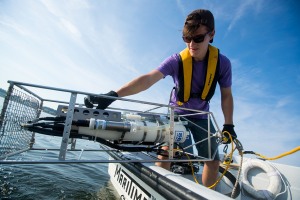PROVIDENCE, R.I. [Brown University] — Each summer, visitors flock to Yellowstone National Park to take in its splendors. This year, Brown University student Eliza Atwood is among them — but as a researcher, not a tourist.
Atwood, a rising senior concentrating in environmental science, is based out of Montana for eight weeks, where she starts most mornings out in the field collecting bison fecal samples. In tandem, she and the other members of the research team gather plant samples that they press and bag, which they use to cross-reference plant traces found in the feces.

Their work is contributing to an ongoing research project aimed at deepening biologists’ knowledge of the food web for bison and other large mammalian herbivores in Yellowstone. The data will help expand an understanding of how their diets can sustain their epic annual migrations across the ecosystem, and ways that disturbances in the system may have adverse effects.
“Through the samples, we’re learning a lot about nutrition of the bison in particular — and other large herbivores in the park like mule deer, bighorn sheep, pronghorn sheep and elk,” Atwood said.
A departure from her average day as a student at Brown, where she rows for the University’s women’s crew team and works as an undergraduate teaching assistant in biology, Atwood is spending the summer at Yellowstone collaborating with Tyler Kartzinel, an assistant professor of ecology, evolution and organismal biology at Brown.
It was Kartzinel’s Conservation in the Genomics Age class in the Fall 2022 semester that deepened her interested in field research.
“His class was really great at accelerating learning techniques about formal research and lab work,” said Atwood, who is from Sewickley, Pennsylvania.
Atwood’s research internship, which is funded through Brown’s Summer Undergraduate Teaching Research Awards, is providing her with hands-on experience in wildlife ecology research. She is thrilled that she gets to work as part of a professional collaboration between Brown University researchers and the National Park Service — all while exploring one of the nation’s most treasured and iconic wildlife conservation areas.
“When we’re not working, we’re hiking, we’re getting to see a ton of wildlife,” she marveled.
_0.jpg)
When it comes to the daily task of collecting waste samples from bison — animals that can weigh up to 2,000 pounds — it’s a process that requires caution and fortitude.
“You have to first make sure you’re a safe distance away from the animal you’re collecting samples from,” she said. “It’s really a nitty gritty process — not to mention sweaty, smelly and exhausting.”
Once late afternoon arrives and the sun begins to cast shadows on the grassland prairie, the team returns to the lab, where they organize and log samples into databases. To properly identify plant species, the team combs through books and other research papers to find clues and figure out “which plant is which,” Atwood said.
The fecal samples are analyzed using DNA metabarcoding technology — which allows for comprehensive identification of plants within the same sample. As part of the team’s ongoing research in the park, fecal samples collected from last year are being processed and sequenced in addition to this year’s samples, Atwood said. Park rangers also collect samples throughout the winter that are stored in the freezer.
The team is also studying small plots of land scattered throughout the park to better understand what plants thrive together and the ways that animal grazing impacts their regeneration.
